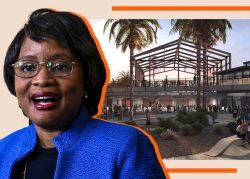Southern California’s largest transit agency will give up surplus land to house as many as 10,000 homeless residents.
LA Metro will scour its properties for surplus, vacant and underused land that could be turned into housing for homeless residents, the Los Angeles Daily News reported.
The Los Angeles County Metropolitan Transportation Authority board voted unanimously to amass an inventory of surplus property for future developers to build temporary or permanent shelters.
Such properties could include unused land near train stations or empty parking lots.
“Everyone knows that about 1,000 people take shelter on Metro (trains and buses) every day who are homeless,” Los Angeles Mayor Karen Bass, a Metro board member who spearheaded the motion, told the newspaper. “The idea of Metro property being used for affordable housing is part of that continuum.”
Metro aims to create 10,000 homes to shelter homeless residents on its excess land, the agency reported.
“People don’t look at us as a housing institution but in a way we are,” said L.A. County Supervisor Hilda Solis, a Metro board member. “This is something close to your heart and mine.”
Developers usually snag the land next to new Metro train lines for luxury apartments.
From Pasadena to Downtown Los Angeles to Monrovia, apartments and townhomes have been built for working professionals who want a quick train trip to jobs. Metro now wants to pivot to affordable housing.
A 232-unit affordable housing complex was built on land once set aside for a county jail at 1060 North Vignes Street near L.A. Union Station, Solis said. She added that the adjacent land owned by Metro could be used for similar apartments.
Pomona Mayor Tim Sandoval suggested an affordable housing development could be built on or near a parking lot next to the North Pomona L (Gold) Line Station, slated to open in January 2025.
“There is property there to be considered,” he said. “It is important to create opportunities for people who don’t historically have access to housing near transit.”
In an executive order this month, Bass ordered a list of all city-owned property that is vacant, surplus or underused to be given to the city’s housing czar, who will determine its suitability for homeless housing. The city report is expected in early March.
Metro CEO Stephanie Wiggins was ordered to report back to the board’s executive management committee at the end of March with a list of Metro properties feasible for housing.
A full report on how to streamline the transfer of property, which usually involves a $1 per year lease, is expected to come to the full board at the end of April. The report updates Metro’s property holdings, last calculated about three years ago, Bass said.
Read more



“When thinking about Metro-owned property for housing, it would be nice to refer someone to a location off the line, like a parking lot with a mixed use, with permanent supportive housing with drug treatment,” Bass said.
In July, Metro voted to buy up land next to proposed train stations, then sell parcels to affordable housing developers with rules that ensure low rents, prohibit speculation and stymie gentrification.
— Dana Bartholomew
